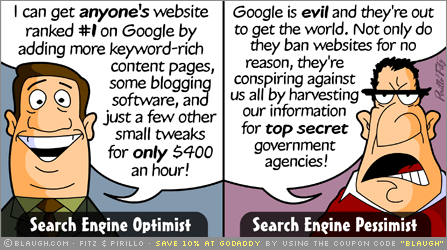 (I would give a link credit but the site was having issues loading – funny)
(I would give a link credit but the site was having issues loading – funny)Now I feel compelled to clear the air for all SEOs, web analysts and conversion specialists. We’re not pessimistic, however our jobs are such that we dig to find issues that need fixing. By nature we need to communicate those issues (problems) with other stakeholders in an organization, whether those are peers, management or clients. I have always tried to practice a ‘good bedside manner’ during those communications. Perhaps I missed from time to time. I apologize.
You see, I’m the son of an Auditor and an Editor – I was born for this shit to analyze, assess risk and fix issues.
For the record, I’m not referring to the optimist vs. tin-foil hat pessimist in the cartoon above. The SEO work I am referring to is not your granddads SEO. We’re not talking about placing keywords here, there and everywhere. I’m not even talking about the processes of link building, keyword research and on-site targeting, though those do have a place. What I’m discussing with you is technical SEO, brand strategy and conversion optimization. We are discussing modern digital marketing. Modern SEO. These are topics that require serious discussion and intense critique. They are also topics that elicit great emotion in marketers, which is awesome! I believe that’s key to understanding the perception of others as I’ve presented a site audit or a testing plan to those, equally passionate marketers. Essentially, I’ve rejected their ideas and presented my own, backed up by data (the auditor in me). That can be tough.

What is the job of the SEO?
I’m not going to answer the question entirely but I will list some relevant tasks that can lead to a missed perception of an SEO or their intent.
1. Diagnose technical, usability and conversion problems
Every site has technical SEO problems. These are barriers to a site’s ability to rank well in search engines – the core of SEO. Ranging from architecture to page speed to seemingly unavoidable duplicate content problems, these represent the bread-and-butter for technical SEOs. On the misinterpretation scale, these don’t register, they’re merely our core strengths and I’d ask the general marketing community to allow SEOs our freedom here.
2. Develop a strategy to fix those issues
Here’s where some toes can get stepped on. Presenting an optimization plan outlining all the problems a site has can be taken negatively. Makes total sense. You create a site you’re proud of, and then the SEO comes in and tears it down. We’re not critiquing, we are identifying areas of improvement. A distinction I hope comes across more than any other in this post. Also, the optimization tasks often require delegating work to various team members or other departments (IT) and generally people don’t like to do work. OK that last rant was admittedly pessimistic, but you know it’s true. Again, bedside manner is important here as well as in #4 below.
3. Constantly test new ideas
I read a great article recently titled “Your Design Sucks. And Copy. And Your Idea is Wrong”. Well, yes, but a little bedside manner please? I’m kidding, Peep is right. If you read the post the idea is, your site is always ALWAYS in need of improvement. A site redesign is the first in a long line of steps to striving for an optimized website. Here we’re talking search optimization and conversion optimization. After all, your site exists to attract new customers – constantly. If you don’t agree, then you sir or ma’am are not a member of the marketing industry, you’re in the industry of vanity. Sorry.
4. Teach
Perhaps the most difficult idea I’ll present today – at least for me it is, I struggle with teaching people SEO. This struggle is one of the reasons I blog, to get down on paper the ideas I’d like to share with others. Did I just define blogging? Anyway. Teaching solves the problem of misunderstood intent. Teaching is though, a two way street. The SEO, using his or her most cordial beside manner of course, must present their audit analysis and recommendations in the most encouraging manner. Educating the client, boss or colleague about what the issue is and how to fix it. And assuring them that everything is going to be all right. The flip side is the stakeholder – the boss, client or colleague. They need to be receptive to teaching and the entire audit process/recommendation process. Without their understanding – that the SEO is here to help – then it’s easy to see the pessimist within us.
My final request is to the stakeholders. Please allow your SEOs to do their job. Give them the freedom and support they need and the optimist in me will promise you success.
Here’s to better marketing in 2014! If you have any feedback, please feel free to leave a comment below.

Leave a Reply